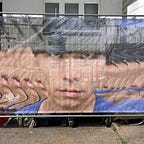SASG Residency Week 10
Week 5 | Week 6 | Week 7 | Week 8 | Week 9
This week, I attended several exhibition openings. On Wednesday, Seoul Mediacity Biennale opened at Seoul Museum of Art. The main theme is artificial intelligence and the exhibition is well curated with a mix of interactive and conceptual works. At the opening, I met Gene, who last time I saw at his workshop at sfpc in New York. He is exhibiting a video that is generated by neural synthesis, which is one of the topics he covered at the workshop. I also met Mario Klingemann, whose work (in the left photo) keeps learning how people look like during the exhibition and show your face based on what it has learnt.
In the same evening, I went to Art Center Nabi for the opening of their residency artist exhibition. I have already met all the residency artists, Amay, Matthias and Sjoerd. Amay has already left the town but did artist talk prior to the exhibition. Amay and Matthias’ topics are blockchain; Matthias’ work Face Trade encodes a mugshot of the participant as a comment of Ethereum transaction and in return gives you a printed artwork with a receipt. Beach Umbrella by Sjoerd uses artificial intelligence to track the change of the city. Seoul is rapidly changing as following trend is an important in East Asian culture. As a result, gentrification can be seen in many sites in Seoul, and Beach Umbrella is a documentary of such change by using object recognition of beach umbrellas, which was once iconic object on the streets but disappearing quickly. He also exhibits a video work about Ikseon-dong Hanok Village, which was a residential area but now is turned into an “Instagram” spot, showing the contrast of past (Google Street View from a few years ago before gentrification) and current (photos from the Instagram feed).
On Thursday and Friday, I visited the opening of Gwangju Biennale. The locations are Biennale hall, Asia Culture Center (ACC) and the former Armed Forces’ Gwangju Hospital. The hospital is an important site as people were hospitalized there during Gwangju Uprising. It was closed in 2007, but since it is a property of the military, the city could not have permission to renovate the building. They have been negotiating with the military for years and this edition of Gwangju Biennale is the first time to open the building to public. In the building, Kader Attia placed wooden pillars from abandoned Hanok in each room of the psychiatric ward. Mike Nelson’s work is installed in a nearby church; he took tens of mirrors from the hospital and hang them from the ceiling of the church.
There are a few new media pieces at ACC. Byun Jaekyu’s Epoxyfilm (right photo) uses a 3D-printed structure and motorized lenses. The transparent films have bumps made of drops of epoxy; thus, the projected images on the walls are not entirely on focus. The lenses are controlled by the motors to shift the focus, which creates an effect similar to the view of a microscope when adjusting the focus.
This coming week, we are hosting the open studio at Seoul Art Space Geumcheon from September 13th to 16th to show pieces that we have been working on during the residency. The opening will be on 14th with audiovisual performance by Evelyne and me as well as a performance by Jae Hyun Shin.
